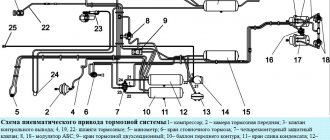PAZ-32053 BUS ENGINE CONTROL SYSTEM
The engine is equipped with an electronically controlled system to maintain stoichiometric mixture composition to ensure efficient operation of the exhaust gas converter.
The ZMZ-52342 microprocessor engine control system is designed to:
— to correct the composition of the air-fuel mixture by controlling the additional air regulator (ADV) supplied after the air filter to the carburetor spacer (above the throttle valve), based on a signal from the oxygen sensor;
— to control lambda regulation depending on the operating modes of the engine and its temperature state in order to ensure conditions for efficient operation of the converter and the engine fulfilling the declared power and economic characteristics.
The functions of starting, warming up and engine operation at minimum idle speed do not depend on the control system and are provided by carburetor settings and the standard ignition system. At minimum idle speed, the composition of the mixture is adjusted manually using the carburetor quality and quantity screws.
In the event of malfunctions in the operation of the control system and faulty components, the control unit generates a signal to the “Engine Diagnostics” warning lamp located on the instrument panel.
Indicator lamp 45 (Fig. 2-4) is yellow when the ignition is turned on (turning the ignition key to position I) and if the engine control system is working properly, it should light up for (2.5) seconds and go out. After which the engine can be started. If, after turning on the ignition, lamp 45 does not go out, this indicates the occurrence of the following malfunctions in the engine control system:
— flashing indication — disturbances in the operation of the oxygen sensor, which do not allow for lambda regulation and require special attention;
— continuous light — other disturbances in the operation of the control system.
If serious malfunctions occur, such as:
— failure of the additional air regulator;
— failure of the crankshaft speed sensor;
— failure of the absolute pressure sensor;
— the on-board network voltage is outside the operating range (from 8 V to 16 V);
— serious disturbances in the functioning of the control unit.
the engine control system cannot operate.
The control system can operate with the following faulty parts:
- oxygen sensor - without the engine meeting the standards for emissions of harmful substances in exhaust gases;
— coolant temperature sensor. The readings of the temperature sensor, if it fails, are calculated based on the operating time of the engine from the moment of start-up and take a fixed value.
Diagnostics of the Mikas 11V8 28.3763 control unit allows you to monitor the technical condition of the system using the ASKAN-10 diagnostic tester from NPP AVTEL LLC. The tester is connected to the control unit via the diagnostic connector.
When operating the engine, maintenance of the control system is not provided. Restoring the system's functionality is done by replacing failed parts.
Rice. 3-15 Schematic diagram of the engine control system 1 - fuel tank; 2- petrol pump; 3- fine fuel filter; 4- air filter; 5-carburato; 6- -mixer; 7, 8 - air ducts; 9- air dispenser; 10- vacuum hose; 11- engine; 12-electronic control unit; 13 - absolute pressure sensor; 14- A-probe; 15- neutralizer
Attention: The electronic auto parts catalog is intended for reference purposes! Our company only sells those products that have prices listed.
| Number | 5234.1000400 |
| Name | Engine ZMZ-5234.10 with equipment without gearbox |
| Quantity per "32053;32054" | 1 |
| Model | 5234 |
| Group | Engine |
| Subgroup | Engine assembly |
| Part serial number | 400 |
History[ | ]
It was developed by creating dozens of prototypes over almost 15 years. The basis was the PAZ-3203 bus, developed in 1972-1977 and prepared for serial production in 1979, but never put into production[2]. The first pilot batch of buses for testing was manufactured in 1979, and assembly line assembly began in 1984[3].
The final version of the bus was approved in 1986. Mass production began on December 1, 1989, when production of the previous PAZ-672M model was completely stopped on the assembly line. On June 4, 2001, the plant celebrated the production of the 100,000th bus of this model. In 2008, production was modernized, which made it possible to carry out certification for regular use on busy routes, the service life of the body increased significantly (from 5 to 10 years), a more efficient heater and more comfortable seats were installed in the cabin.[4] In 2014, production of the restyled version began [5].
Gasoline and bi-fuel engines ZMZ V8 are being discontinued
September rumors have been confirmed: ZMZ V-shaped “eights” are becoming history. Zavolzhsky Motor Plant, part of Sollers, officially confirmed the discontinuation of the ZMZ-523 (gasoline) and ZMZ-524 (bi-fuel) line by the end of this year.
The history of this engine dates back to the late 1950s, when its distant ancestor ZMZ-13 appeared on the Chaika passenger car. Some of its critical parts, including the cylinder block, were made of aluminum - a revolutionary solution at that time. After repeated modernizations, it turned into the ZMZ 500th series, which was installed on trucks of the Gorky Automobile Plant (GAZ-53 and GAZ-66). Later, having evolved to the current generation, it was also used on Lawns-3307/3308. And having left the trucks, it remained the main one for the immortal classic bus PAZ-3205 and its relatives.
The characteristics of the current 500th ZMZ family are as follows: volume - 4.67 liters, cylinder diameter - 92 mm, piston stroke - 88 mm. The cylinder block is still cast from light aluminum alloys. In the gasoline version, the engine power is up to 134 hp, in the dual-fuel version - up to 128 hp. The power system is the good old carburetor or electronically controlled distributed injection.
Of course, this engine is long overdue for retirement. It has long lost its former advantages of V-twin engines - compactness and maintainability - and is inferior to any analogues in terms of efficiency and environmental friendliness. At current prices, gasoline consumption of about 30 liters per hundred is prohibitively high even for a state-owned carrier. It’s the same story with environmental friendliness: if the late gasoline-propane ZMZ-524 somehow managed to reach current emission levels, then what can be done with the carburetor version, officially designed for seventy-sixth gasoline?
Alas, this is bad news for our carriers: they simply don’t have the money for anything else. The program has long had diesel grooves, with a wide selection of power units: YaMZ, MTZ, Cummins, Huadong. But they sell poorly - because they are more expensive! The price of a ZMZ gasoline engine is about 250,000 rubles, and even the D-245 costs almost twice as much. However, given the maintainability and the number of eights produced, they will have to drive for a long time.
But four-cylinder ZMZ passenger engines with a cast iron block remain in production. The UAZs on which they are installed will continue to be produced for a long time - at least according to Sollers management.
Modifications[ | ]
The model is represented by a large number of modifications:
- PAZ-3205 is a basic version with one automatic door, a ZMZ-5234.10 carburetor engine and a pneumatic-hydraulic brake system. Currently out of production.
- PAZ-3205-10 is a bus designed to run on compressed gas, a prototype of which was produced in 1997. The gas cylinders of this car are hidden under a special casing on the roof, installed in place of the third hatch. The bus remained experimental.
- PAZ-3205-20 is a cargo-passenger version of the PAZ-3205 bus, available in several versions with different volumes of the cargo compartment, which is located in the rear of the body. The number of seats is 16. There is no rear emergency door in such buses - its functions are performed by the cargo compartment door in the rear panel. The volume of the cargo compartment can vary from 5.3 to 15 m³.
- PAZ-3205-30 is a bus for disabled people, equipped with a hydraulic lift and mounts for wheelchairs. It was developed in 1998 and initially bore the index PAZ-3208.
- PAZ-3205-40 is a self-propelled chassis based on the components and assemblies of the PAZ-3205 bus. In the 70-80s of the 20th century, the Soviet Union carried out significant volumes of supplies of self-propelled chassis based on the PAZ-672 bus to Cuba, where the customer mounted their bodies on it. In connection with the cessation of production of the 672nd model, it was planned to continue deliveries of the chassis based on the PAZ-3205. However, a change in the political situation did not allow these plans to come true - only a small number of PAZ-3205-40 chassis were sent to Cuba before the collapse of the USSR.
- PAZ-3205-50 is a luxury version developed in the early 1990s. The first experimental buses had the PAZ-3205T index. It differs from standard buses in the installation of soft non-adjustable seats in the cabin on the superstructure (podium), the presence of luggage racks above the seats along the windows and a luggage compartment with a volume of about 2 m³ in the rear of the cabin.
- PAZ-3205-60 - the northern version of the bus was developed back in the eighties of the 20th century, and the first prototype, then called PAZ-320501, appeared in 1984. It differs from the base model in improved thermal insulation, double glazing, and a driver's cabin completely separated from the passenger compartment. The heating system is calorific - from a radiator and 3 heaters connected to the engine cooling system.
- PAZ-3205-70 - this index was originally assigned to the PAZ-3205 diesel bus, which appeared in 1995. However, it was soon changed to PAZ-3205-07, and a school bus is now produced under the designation PAZ-3205-70. It differs from the basic model in four steps, of which the lower one is retractable, seats with a semi-soft high back, seat belts on each seat, and a driver signal button near each seat. The bus is also equipped with shelves for schoolchildren's backpacks, and there is space for two wheelchairs when folded. A reflective strip is applied along the perimeter of the body, and a megaphone is installed on the roof.
- PAZ-3205-70[6] RAP - a variant of a school bus with Belarusian components. Gearbox: GAZ mech., 4-speed (gasoline) or SAAZ mech., 5-speed (diesel).[7]
- PAZ-32051 is a bus with two automatic doors for suburban routes (often installed on city routes) and a pneumatic-hydraulic braking system (the location of the seats in the cabin differs for one-door and two-door modifications). Currently out of production.
- PAZ-32052 - experimental with one wide automatic door for city routes; did not go into series.
- PAZ-32053 is a bus with one automatic door for suburban routes and a pneumatic braking system with ABS. It is a replacement for PAZ-3205.
- PAZ-32053 RAP is a version of a gasoline bus with Belarusian components. Gearbox: GAZ mech., 4-speed [8]
- PAZ-32053-07 RAP is a version of a diesel bus with Belarusian components. Gearbox: SAAZ mech., 5-speed [9]
- PAZ-32053-20 is a cargo-passenger bus for transporting construction crews and equipment.
- PAZ-32053-27 - cargo and passenger with a diesel engine MMZ 245.7.
- PAZ-32053-50P is a bus with one automatic door for suburban routes with an improved interior.
- PAZ-32053-57 - commuter with MMZ 245.7 diesel engine.
- PAZ-32053-60 - a bus in the northern version.
- PAZ-32053-67 - northern with a diesel engine MMZ 245.7.
- PAZ-32053-70 - school bus.
- PAZ-32053-77 - school car with MMZ 245.7 diesel engine.
- PAZ-320538-70 - school car in northern version.
- PAZ-32053-80 - ritual bus.
- PAZ-32054 is a bus with two automatic doors for city routes, a ZMZ-5234.10 carburetor engine and a pneumatic braking system with ABS. It is a replacement for PAZ-32051.
- PAZ-32054-03 is a bus with two automatic doors for city routes with a Cummins B 3.9 140 CIV-1 diesel engine.
- PAZ-3798 is an isothermal van.
- PAZ-3975 is a mobile laboratory for a comprehensive examination of athletes at competition sites. The model was developed by order of the USSR State Sports Committee in 1987.
- PAZ-3206 is an all-wheel drive modification. Designed to operate in remote areas through difficult terrain.
Interior design and features
The internal structure of the PAZ 32053 is not elegant. But it has a long service life and keeps the interior decoration at a decent level for a long time. The bus is equipped with an all-metal body of a load-bearing carriage type. The expected service life during production is 5-7 years. After completion of the specified period, it will be necessary to carry out anti-corrosion treatment. The cabin is designed for 43 passengers, of which 25 will be provided with seats. For boarding, there is a single double-leaf swing door with automatic opening, the width of which is 726 millimeters.
There is also an emergency exit in the rear overhang in the form of an ordinary door with manual opening. The seats in the cabin are covered with thick fabric that is resistant to abrasion and other types of wear. It often has a dark brown color, on which traces of dirt are not so visible. The seats are permanently installed and do not have a sprung base, so passengers will feel all the bumps in the road. Early bus models were equipped with double seats without a divider. Single seats are now being installed for each passenger.
The driver's seat is much more comfortable. It has a spring base that softens the shakes and suppresses most vibrations, and it can also be moved closer or further from the dashboard and set the desired angle of the backrest. There is nothing superfluous on the dashboard. Only the necessary indicators are always in the viewing area. The glass is equipped with an anti-reflective surface, which helps you navigate without problems in sunny weather.
Ventilation is carried out through vents and hatches without forced exhaust. The heater is a calorifier type. It transfers heat from the engine cooling system into the cabin. There is also a northern modification of the bus, which has double glazing and an additional autonomous interior heater. In addition, it is possible to re-equip the fuel system for gas equipment. This allows you to significantly reduce refueling costs.
Payback will occur after just a few months of operating the bus in standard mode. Sometimes owners order installation of air conditioners from third-party companies to improve passenger comfort. There is also a modification PAZ 32053-77, which is used as a school bus. It has a forced speed limit of 60 kilometers per hour, and each seat in the cabin is equipped with a seat belt.
Specifications[ | ]
| Specifications | |
| Body | Carrier, carriage layout |
| Wheel formula | 4 × 2 |
| Total number of seats | 41 |
| Number of seats | 25 |
| Maximum speed, km/h | 90 |
| Control fuel consumption at 60 km/h, l/100 km | 19 |
| Fuel tank capacity, l | 105 |
| Brake system | pneumatic, dual-circuit with ABS |
| Length, mm | 7000 |
| Width, mm | 2530 |
| Height, mm | 2880 |
| Base, mm | 3600 |
| Total weight, kg | 7610 |
| Equipped with engines | ZMZ-5234.10, YaMZ 534, MMZ 245.7 |
| Ventilation | 3 hatches in the roof, vents on the side windows |
| Steering gear | MAZ-64229 with power steering |
Review of the main technical characteristics of the bus
The technical characteristics of the PAZ 32053 are noticeably behind those of foreign-made buses. But all components and assemblies are well adapted for operation in the harsh domestic realities and have a large margin of safety. The chassis is capable of effectively resisting the destructive effects of off-road conditions for a long time. All systems can operate on low quality fuels and lubricants. So this is exactly the model that is needed for the Russian outback, because not a single imported analogue will withstand such tests.
The PAZ 32053 engine runs on AI-92 gasoline. Fuel consumption is 20.5 liters per hundred kilometers. Model ZMZ-5234.10 is an eight-cylinder engine with a V-shaped cylinder arrangement. Engine volume is 4.67 liters. Developed power is 130 “horses” at 3200 rpm. The maximum torque value is observed at 2250 crankshaft revolutions and corresponds to 314 N*m. According to the international environmental safety classification, the engine falls under the EURO-3 standard. According to the technical data sheet, the maximum speed is 80 kilometers per hour. Since 2011, some bus models have been equipped with a YaMZ-534 diesel power unit.
This is a four-cylinder, in-line, four-stroke engine with a liquid cooling system. The turbocharger is equipped with an intermediate cooling system for the incoming air. The fuel consumption of the PAZ 32053 with such an engine is 22 liters per 100 kilometers. Power is 190 “horses” at 2300 rpm. The torque is 710 N*m at a speed of 1300-1600 rpm. The cylinder displacement is 4.43 liters, the compression ratio is 17.5. The level of exhaust gas emissions into the atmosphere corresponds to the EURO-4 value. The maximum speed is 90 kilometers per hour.
The PAZ 32053 clutch is a single-plate, damper, permanently closed, dry type with a hydraulic drive and a pneumatic booster. The bus can be equipped with one of two gearboxes - either a four-speed manual model GAZ-3307-1700010-11, or a five-speed manual SAA3 320670-1700010. The brake system PAZ 32053 is a drum type, pneumatic, dual-circuit with axial separation. Service brakes apply to all wheels, while parking brakes apply only to the rear wheels. If emergency braking is necessary, the driver can count on the ABS system, which is included in the basic package. The steering mechanism of modern vehicles cannot do without a hydraulic booster. This element is installed on all buses starting from 2011.
Dimensions: external - 7x2.53x2.88 meters, ceiling height in the cabin - 1.965 meters, wheelbase - 3.6 meters, front/rear track - 1.94/1.69 meters, ground clearance - 320 millimeters. For a complete turn you will need 7.6 meters. The curb and gross weights are of little importance for a bus and are 5.61 and 8.39 tons, respectively. Axle load distribution: front axle - 3.115 tons, rear axle - 5.275 tons. The formula for wheel drives is 4x2. Wheel tire size is 8.25 R20.
Unscheduled "groove"
Believe it or not, the PAZ-3205 was not a consequence of the planned update of the model range. On the contrary, it was the result of the refusal to produce a new model - PAZ-3203.
braking system with mechanisms from GAZ-53–11, rear leaf spring suspension with correction springs, 5.5-liter ZMZ-3203 engine, as well as a 5-speed gearbox, cardan transmission and power steering from ZIL-130, showed the breadth of views of PAZ designers , and... the inability of subcontractors to fulfill their request. The sad result is that the “3203” family died without being born...
Naturally, the plant could not come to terms with this state of affairs, and as an alternative proposal, the idea arose to crossbreed a new body with an old chassis, naturally, making all possible modifications to the latter. So, in April 1978, they first started talking about the “3205” family. The first prototype of the PAZ-3205 was assembled in the summer of 1979.
Despite a significant percentage of unification and external similarity with the buses of the 3203 series, the 3205 differed in interior layout and had a number of design differences in the body. One of the significant features of the PAZ-3205 was the original pneumohydraulic braking system, which made it possible to eradicate one of the main problems of the PAZ-672 - the insufficient efficiency of service brakes with a hydraulic vacuum drive.
The steering mechanism has also changed - the use of a screw - ball nut type with a built-in hydraulic booster (from MAZ-5336) made it possible to reduce the number of flexible hoses by 60%, increasing the reliability of the unit. The suspension was not left without attention: narrowing the spring track made it possible to reduce the turning radius, and elongated front springs, together with the installation of correction springs in the rear suspension, increased the smoothness of the ride.
And then the family developed. During the year, prototypes of the PAZ-3205 of the second series were released - two buses in the basic version and an urban modification of the PAZ-32051 with two automatic service doors. In 1981, two more PAZ-3205 samples were built for interdepartmental testing, which were successfully completed in 1982 with a recommendation for production.
During 1983, using revised technical documentation, five pre-production samples of the PAZ-3205 were assembled in the experimental workshop, and in 1984, “3205” first appeared in the plant’s annual report as a commercial product: in November–December, five buses were manufactured at the small-scale production site.
However, for another five years, the PAZ-3205, assembled “by hand,” was just a “by-product” to the PAZ-672M. And only on January 28, 1989, the process of “marriage” of the body and chassis of the “3205” took place on the main assembly line, and not in the small series workshop. And the PAZ-3205 began its full “conveyor” life on December 1, 1989.
By this time, the plant had already developed and implemented 10 different modifications in metal, and “3205” became a full-fledged family. The first of them was the urban version of the PAZ-32051 with two automatic doors; in 1982, the all-wheel drive PAZ-3206 appeared, which completed testing by December 1986, but... commercial vehicles saw the light of day only in 1994.
In 1984, by order of the CPSU Central Committee, one of the built PAZ-3205 models was converted in the experimental workshop into a tourist-type bus with high-back seats, improved interior trim, stereophonic radio equipment and an insulated trunk.
In 1985, the plant prepared technical projects for the northern and southern modifications - PAZ-320501 and PAZ-320509, respectively, embodied “in metal” in 1986.
At the same time, it was decided to include diesel engines under the hood - the domestic GAZ-542 and the Japanese Hino W04CT. The first diesel “grooves” entered testing in 1987, but due to the complexity of the layout, the “Gazovsky” engine dropped out of the race almost immediately, and the expensive Japanese diesel engine was only supplied to order in the early 90s, and its production did not exceed several dozen .
In 1987, technical specifications and technical documentation were prepared for the PAZ-3205-10 bus with propane gas equipment, prototypes of which were built in 1987 (1 piece), 1988 (2 pieces) and 1989 (1 piece).
Development work on these machines was carried out jointly with designers from the PAZ, GAZ and ZMZ plants. Production of buses of the PAZ-3205 series for 1989–2000.
| Year | 1989 | 1990 | 1991 | 1992 | 1993 | 1994 | 1995 | 1996 | 1997 | 1998 | 1999 | 2000 |
| PAZ-3205 | 307 | 8004 | 9680 | 10 342 | 11 070 | 9073 | 7800 | 7235 | 8679 | 8500 | 7495 | 8060 |
Production of buses of the PAZ-3205 series for 2001–2013.
| Year | 2001 | 2002 | 2003 | 2004 | 2005 | 2006 | 2007 | 2008 | 2009 | 2010 | 2011 | 2012 | 2013 |
| PAZ-3205 | 10 126 | 10 131 | 10 249 | 10 520 | 11 546 | 11 680 | 11 728 | 11 661 | 5733 | 6380 | 6726 | 7089 | 6151 |
| PAZ-4234 | – | – | 709 | 1232 | 1792 | 2111 | 2534 | 1869 | 1104 | 1382 | 1823 | 1722 | 1282 |
Bus repair, maintenance and price
Maintenance and repair of PAZ 32053 enjoys good reputation among mechanics. All parts, systems and mechanisms have a clear design and easy access. To help beginners, the manufacturer provides detailed instructions that will help you quickly find the problem and quickly fix it. The high level of unification of parts with other buses from the Pavlovsk plant makes it possible to obtain the necessary parts without any problems.
With timely servicing, the engine will cover hundreds of thousands of kilometers before major repairs. It is enough to ensure that the level of working fluids does not fall below the minimum mark and comply with all the manufacturer’s requirements. The main malfunctions of the PAZ 32053 are related to the poor quality of roads and affect the chassis. But here everything depends on the driver; the more carefully he behaves, the longer the vehicle will last. Taking good care of your equipment will extend its trouble-free use and save money from the repair fund.
Buses of this model are in great demand both in government services and among private individuals. Low cost and excellent characteristics contribute to its competitiveness in the domestic market. The model is also exported to the CIS countries. Many enterprises purchase a bus for use as official transport to transport workers to their place of work from nearby settlements.
The price of PAZ 32053 at the beginning of June 2014 is approximately 1 million rubles. It takes very little time for the vehicle to pay for itself with regular trips to the route. The warranty period is 12 months for petrol models and 18 months for diesel. During this period of time, you can contact the manufacturer in the event of a breakdown and receive free service or replacement of the failed part.
Long term {q}
And then the PAZ-3205 began the normal life of a production car. Current improvements, the emergence of new modifications, the introduction of new units and adaptation to increasingly stringent certification requirements. In this routine, a bright spot was the appearance in 2003 of an extended modification of the PAZ-4234 for operation on urban and suburban routes.
Well, at present, the “3205” family is not only not going to “retire”, but is also growing with new configurations. New engines are being adopted in the engine compartment, the appearance is changing, and unique versions are appearing, designed for specific customers abroad.
However, there is no need for words when you can look at the dry statistics of buses produced. It is logical that the production of the model, which celebrated its 25th anniversary, is declining, giving way to the more modern Vector family. But the most complete pessimist would probably not risk saying that the production of PAZ-3205 is being curtailed...
Tales for VIP
Over the 25 years of its existence on the assembly line, the “3205” family has acquired many interesting modifications and designs. This list includes dozens of buses, and if we talked about each of them, we could devote an entire magazine. We have collected the most striking examples of the family, emphasizing that in Pavlovo they did not sit idly by, basking in the rays of glory, but tried to keep up with the times, tracking both fashion trends and market demands, producing models in which the PAZ-3205 was sometimes don't know...
Tales for VIP
Over the 25 years of its existence on the assembly line, the “3205” family has acquired many interesting modifications and designs. This list includes dozens of buses, and if we talked about each of them, we could devote an entire magazine. We have collected the most striking examples of the family, emphasizing that in Pavlovo they did not sit idly by, basking in the rays of glory, but tried to keep up with the times, tracking both fashion trends and market demands, producing models in which the PAZ-3205 was sometimes don't know...










